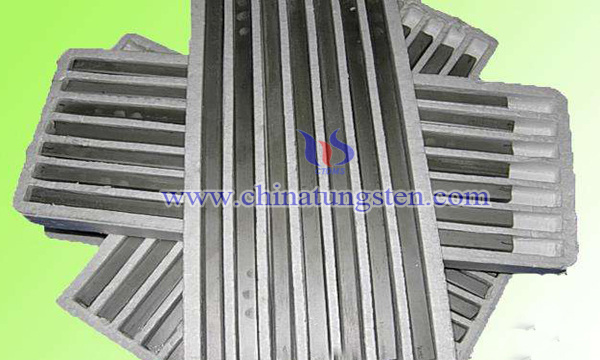Secondary Sintering Process of Potassium Containing Metal Tungsten Bars
- Details
- Category: Tungsten Information
- Published on Monday, 12 November 2018 00:19
potassium containing tungsten bars are raw materials for making light source materials, high-temperature heaters and high-temperature resistant components. The traditional production method is to add silicon, aluminium, potassium and other elements into tungsten oxide powder first, then reduce the tungsten oxide powder doped with these elements and wash it with hydrochloric acid and hydrofluoric acid to obtain doped tungsten powder, then doped tungsten powder. After being pressed, the strips are sintered and sintered to obtain potassium containing tungsten bars.

The ultimate goal of the traditional tungsten production method is to dope a certain amount of potassium into tungsten bars to form potassium bubbles in the subsequent production process, prevent the sliding of tungsten grain boundaries, thereby improving the high temperature resistance and sagging resistance of tungsten wires. Potassium must exist with silicon and aluminium in tungsten bars before it can be doped into tungsten and eventually retained in tungsten bars, while silicon and aluminium must be removed as impurities in the process of acid pickling and sintering, otherwise it will cause serious harm to its subsequent processing.
In order to effectively improve the density of tungsten bars containing potassium, the distribution of potassium in tungsten bars, the uniformity of cross-section crystallization of tungsten bars, the quality of products and the subsequent processing and the performance of products, etc. During the sintering process of tungsten bars, some researchers changed the primary sintering to secondary sintering, and adjusted the corresponding parameters to obtain high strength compacts, which greatly improved the yield of compacts. Its production methods include:
A.Preparing doped blue tungsten powder: Put the original blue tungsten powder (WO2.9) and the mixed solution of H2SiO3 and KOH containing SiO2:0.2-0.6wt% and K2O:0.2-0.6wt% and A l(NO3)3 containing Al2O3:0.02-0.1wt% in the agitator according to the weight percentage of blue tungsten powder. After mixing at 50 to 90 ℃ for 3 to 5 hours, drying at 100 to 200 ℃ for 3 to 6 hours to obtain doped blue tungsten powder;
B.Reduction treatment: The doped blue tungsten powder was put in the boat at 500-950 C and hydrogen atmosphere for 8-12 hours. After cooling, the doped tungsten powder was obtained through 100-200 mesh sieve.
C.Pickling: firstly, the doped tungsten powder is pickled with dilute hydrochloric acid at a concentration of 3 to 6 wt% for 30 to 60 minutes, then the supernatant liquid is removed, and then hydrofluoric acid having a concentration of 3 to 6 wt% is added, and washed. The content of Si in the powder is ≤250ppm, the content of Al is ≤30ppm, and then dried under vacuum at 70~150°C for not less than 10 hours. After drying, it is dispersed and removed by 160~200 mesh sieve;
D Compact: pressing the powder from ℃ into 150 to 250MPa pressure to form the doped tungsten bar.
E.Pre-sintering: The compacted billet is placed in a boat dish and sintered for 30-60 minutes in hydrogen atmosphere and at 1100-1400 ℃.
F.Vertical melting sintering: The pre-sintered slab is placed in the vertical melting furnace, sintered 10-25 minutes under the condition of hydrogen atmosphere and 70-92% current intensity of melting current, and then cooled with the furnace to obtain the non-compact tungsten bar containing potassium.
G.Indirect sintering: The tungsten bars obtained in F process are placed in an intermediate frequency furnace or a tungsten bar furnace, sintered for 2-6 hours in hydrogen atmosphere and at temperatures of 2000-2300 ℃, and then the potassium containing tungsten bars are obtained after the furnace is cooled.
The sectional grain size of potassium containing tungsten bars obtained by secondary sintering process is fine and uniform, the number of grain is more than 8000/mm2, the density is over 18.0g/cm3, and the density difference of the same batch is less than 0.15g/cm3. The sintering time of vertical melting is only about 50% of the traditional technology, and the second sintering process can sinter 500-600 kg at a time, which can not only improve productivity but also produce the same batch. The consistency of the products has also been greatly improved, which effectively reduces the breakage of the billet and the reject rate.
- Tungsten Metals Manufacturer & Supplier, Chinatungsten Online: www.tungsten.com.cn
- Tungsten News & Prices of China Tungsten Industry Association: www.ctia.com.cn
- Molybdenum News & Price: news.molybdenum.com.cn
- Tel.: 86 592 5129696; Fax: 86 592 5129797; Email: sales@chinatungsten.com



 sales@chinatungsten.com
sales@chinatungsten.com